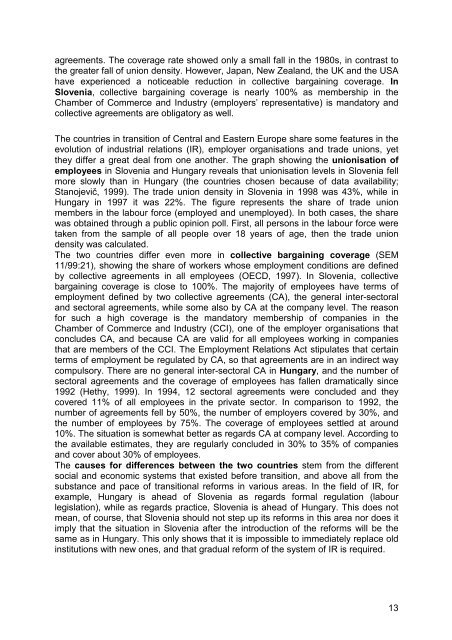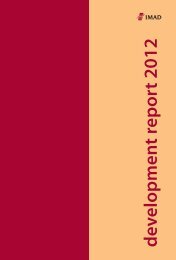The Development of New Industrial Relations in Slovenia - UMAR
The Development of New Industrial Relations in Slovenia - UMAR
The Development of New Industrial Relations in Slovenia - UMAR
You also want an ePaper? Increase the reach of your titles
YUMPU automatically turns print PDFs into web optimized ePapers that Google loves.
agreements. <strong>The</strong> coverage rate showed only a small fall <strong>in</strong> the 1980s, <strong>in</strong> contrast to<br />
the greater fall <strong>of</strong> union density. However, Japan, <strong>New</strong> Zealand, the UK and the USA<br />
have experienced a noticeable reduction <strong>in</strong> collective barga<strong>in</strong><strong>in</strong>g coverage. In<br />
<strong>Slovenia</strong>, collective barga<strong>in</strong><strong>in</strong>g coverage is nearly 100% as membership <strong>in</strong> the<br />
Chamber <strong>of</strong> Commerce and Industry (employers’ representative) is mandatory and<br />
collective agreements are obligatory as well.<br />
<strong>The</strong> countries <strong>in</strong> transition <strong>of</strong> Central and Eastern Europe share some features <strong>in</strong> the<br />
evolution <strong>of</strong> <strong>in</strong>dustrial relations (IR), employer organisations and trade unions, yet<br />
they differ a great deal from one another. <strong>The</strong> graph show<strong>in</strong>g the unionisation <strong>of</strong><br />
employees <strong>in</strong> <strong>Slovenia</strong> and Hungary reveals that unionisation levels <strong>in</strong> <strong>Slovenia</strong> fell<br />
more slowly than <strong>in</strong> Hungary (the countries chosen because <strong>of</strong> data availability;<br />
Stanojevič, 1999). <strong>The</strong> trade union density <strong>in</strong> <strong>Slovenia</strong> <strong>in</strong> 1998 was 43%, while <strong>in</strong><br />
Hungary <strong>in</strong> 1997 it was 22%. <strong>The</strong> figure represents the share <strong>of</strong> trade union<br />
members <strong>in</strong> the labour force (employed and unemployed). In both cases, the share<br />
was obta<strong>in</strong>ed through a public op<strong>in</strong>ion poll. First, all persons <strong>in</strong> the labour force were<br />
taken from the sample <strong>of</strong> all people over 18 years <strong>of</strong> age, then the trade union<br />
density was calculated.<br />
<strong>The</strong> two countries differ even more <strong>in</strong> collective barga<strong>in</strong><strong>in</strong>g coverage (SEM<br />
11/99:21), show<strong>in</strong>g the share <strong>of</strong> workers whose employment conditions are def<strong>in</strong>ed<br />
by collective agreements <strong>in</strong> all employees (OECD, 1997). In <strong>Slovenia</strong>, collective<br />
barga<strong>in</strong><strong>in</strong>g coverage is close to 100%. <strong>The</strong> majority <strong>of</strong> employees have terms <strong>of</strong><br />
employment def<strong>in</strong>ed by two collective agreements (CA), the general <strong>in</strong>ter-sectoral<br />
and sectoral agreements, while some also by CA at the company level. <strong>The</strong> reason<br />
for such a high coverage is the mandatory membership <strong>of</strong> companies <strong>in</strong> the<br />
Chamber <strong>of</strong> Commerce and Industry (CCI), one <strong>of</strong> the employer organisations that<br />
concludes CA, and because CA are valid for all employees work<strong>in</strong>g <strong>in</strong> companies<br />
that are members <strong>of</strong> the CCI. <strong>The</strong> Employment <strong>Relations</strong> Act stipulates that certa<strong>in</strong><br />
terms <strong>of</strong> employment be regulated by CA, so that agreements are <strong>in</strong> an <strong>in</strong>direct way<br />
compulsory. <strong>The</strong>re are no general <strong>in</strong>ter-sectoral CA <strong>in</strong> Hungary, and the number <strong>of</strong><br />
sectoral agreements and the coverage <strong>of</strong> employees has fallen dramatically s<strong>in</strong>ce<br />
1992 (Hethy, 1999). In 1994, 12 sectoral agreements were concluded and they<br />
covered 11% <strong>of</strong> all employees <strong>in</strong> the private sector. In comparison to 1992, the<br />
number <strong>of</strong> agreements fell by 50%, the number <strong>of</strong> employers covered by 30%, and<br />
the number <strong>of</strong> employees by 75%. <strong>The</strong> coverage <strong>of</strong> employees settled at around<br />
10%. <strong>The</strong> situation is somewhat better as regards CA at company level. Accord<strong>in</strong>g to<br />
the available estimates, they are regularly concluded <strong>in</strong> 30% to 35% <strong>of</strong> companies<br />
and cover about 30% <strong>of</strong> employees.<br />
<strong>The</strong> causes for differences between the two countries stem from the different<br />
social and economic systems that existed before transition, and above all from the<br />
substance and pace <strong>of</strong> transitional reforms <strong>in</strong> various areas. In the field <strong>of</strong> IR, for<br />
example, Hungary is ahead <strong>of</strong> <strong>Slovenia</strong> as regards formal regulation (labour<br />
legislation), while as regards practice, <strong>Slovenia</strong> is ahead <strong>of</strong> Hungary. This does not<br />
mean, <strong>of</strong> course, that <strong>Slovenia</strong> should not step up its reforms <strong>in</strong> this area nor does it<br />
imply that the situation <strong>in</strong> <strong>Slovenia</strong> after the <strong>in</strong>troduction <strong>of</strong> the reforms will be the<br />
same as <strong>in</strong> Hungary. This only shows that it is impossible to immediately replace old<br />
<strong>in</strong>stitutions with new ones, and that gradual reform <strong>of</strong> the system <strong>of</strong> IR is required.<br />
13
















